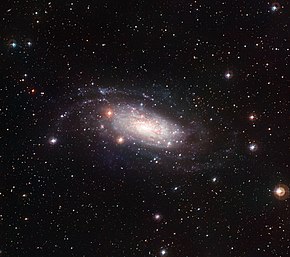| NGC 3621 | |
|---|---|
 NGC 3621 taken by the Wide Field Imager (WFI) at ESO's La Silla Observatory | |
| Observation data (J2000 epoch) | |
| Constellation | Hydra |
| Right ascension | 11h 18m 16.52s[1] |
| Declination | –32° 48′ 50.7″[1] |
| Redshift | 0.002435 ± 0.000007[2] |
| Heliocentric radial velocity | +727[3] km/s |
| Distance | 21.7 million light years (6.64 Mpc)[4] |
| Apparent magnitude (V) | 9.56[5] |
| Characteristics | |
| Type | SA(s)d[1] |
| Mass | 2 × 1010[1] M☉ |
| Apparent size (V) | 10.96′ × 4.79′[5] |
| Other designations | |
| UGCA 232, MCG -05-27-008, PGC 34554[5] | |
NGC 3621 is a field spiral galaxy about 22 Mly (6.7 Mpc) away[4][6] in the equatorial constellation of Hydra. It is comparatively bright and can be well seen in moderate-sized telescopes. The galaxy is around 93,000 ly (29,000 pc) across and is inclined at an angle of 66° from being viewed face on.[7] It shines with a luminosity equal to 13 billion times that of the Sun.[8] The morphological classification is SA(s)d,[1] which indicates this is an ordinary spiral with loosely wound arms.[9] There is no evidence for a bulge.[10] Although it appears to be isolated,[9] NGC 3621 belongs to the Leo spur.[8]
This galaxy has an active nucleus that matches a Seyfert 2 optical spectrum, suggesting that a low mass supermassive black hole is present at the core. Based upon the motion of stars in the nucleus, this object may have a mass of up to three million times the mass of the Sun.[10]
One supernova has been observed in NGC 3621: SN 2024ggi (type II, mag. 18.9).[11] It was discovered on 11 April 2024, and by 16 April it had brightened to magnitude 12. It is the closest supernova to Earth since SN 2023ixf, which was discovered on 19 May 2023.
- ^ a b c d e Cite error: The named reference
AJ750_2_122was invoked but never defined (see the help page). - ^ Cite error: The named reference
APJ128_1_16was invoked but never defined (see the help page). - ^ Cite error: The named reference
APJSS96_1_123was invoked but never defined (see the help page). - ^ a b Cite error: The named reference
APJ676_1_184was invoked but never defined (see the help page). - ^ a b c "NGC 3621". SIMBAD. Centre de données astronomiques de Strasbourg. Retrieved 2021-02-24.
- ^ Materne, J. (April 1979). "The structure of nearby groups of galaxies - Quantitative membership probabilities". Astronomy and Astrophysics. 74 (2): 235–243. Bibcode:1979A&A....74..235M.
- ^ Cite error: The named reference
Lang2020was invoked but never defined (see the help page). - ^ a b Cite error: The named reference
OMeara2013was invoked but never defined (see the help page). - ^ a b Cite error: The named reference
Buta2007was invoked but never defined (see the help page). - ^ a b Cite error: The named reference
AJ690_1_1031was invoked but never defined (see the help page). - ^ Transient Name Server entry for SN 2024ggi. Retrieved 12 April 2024.